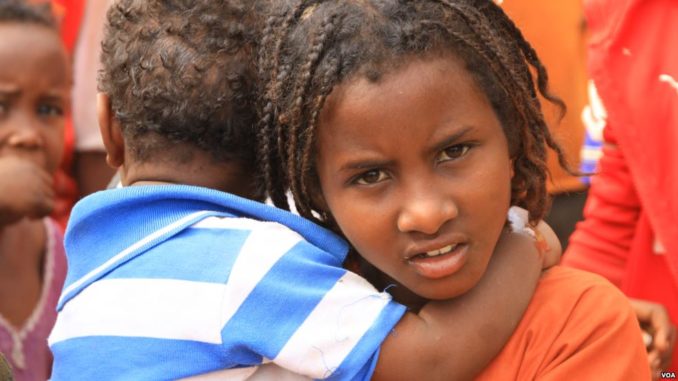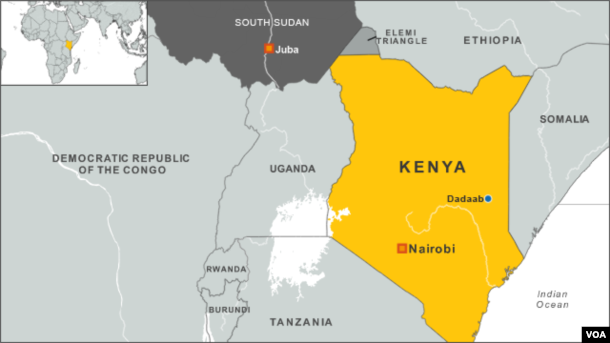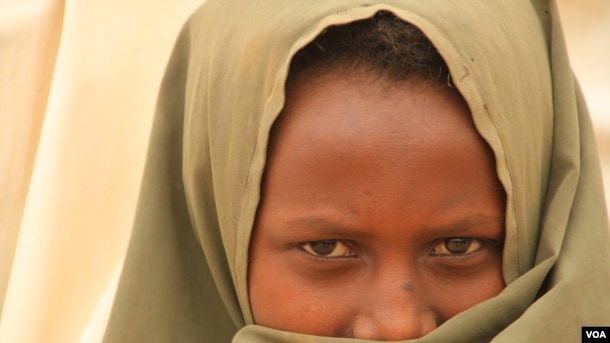
DADAAB, KENYA/KISMAYO, SOMALIA — Twenty-eight-year old Nurto Ahmed Abdullahi stands beside the dusty airstrip at Kenya’s Dadaab refugee camp, preparing to board a charter flight to Mogadishu.
She is one of tens of thousands who after years of seeking refuge in Kenya are going back to their native Somalia as part of a “voluntary repatriation” program backed by the United Nations and the Kenyan government. But Abdullahi and others say the process is hardly voluntary, and accuse Kenya of forcing refugees back to an unsafe country.
Kenya plans to shut the 25-year-old Dadaab refugee camp, which houses nearly 300,000 people, by the end of the year, citing the economic burden and concerns that the camp is a recruiting ground for al-Shabab militants.

The shutdown comes amid cutbacks in health services and food rations in Dadaab that have pushed some refugees who are dependent on aid into destitution.
Business people who once brought goods into the camp aren’t coming either, further reducing the supply of food.
“If someone is complaining about you, you can’t say, ‘I have to stay in his house,’ so you have to decide to leave his house. So Kenya is now going to close Dadaab, and we have to leave Dadaab,” says Abdullahi, who came to the camp in 2011 because of conflict in Mogadishu.
IN PICTURES: Life in Kenya’s Dadaab Refugee Camp

Life in Kenya’s Dadaab Refugee Camp
Meanwhile, those who have returned to Somalia say they’re worse off than they were in Dadaab. Now, many are pointing the finger at the U.N. and Kenya’s government for pushing refugees back to their homes before Somalia is ready to take them.
A preference for Kenya
Over 80 percent of Dadaab residents want to stay put, says Doctors Without Borders, including 48-year-old Fatuma Mahad Samatar, who came to the camp in 2011 from Gedo.
“I’m not ready to go back to Somalia,” says Samatar, who says she has been pleased with the free education for her children, free health care and good security in Dadaab.
Going to Somalia is particularly problematic for the many Dadaab residents born there since the camp opened in 1991, like Mohamed Abdullahi Jimale, 24. He’s never actually been to the war-torn country of his parents, who are both deceased, and has four young siblings to care for.
“I don’t feel like the decision was nice to somebody like me who was born in the camps. And I don’t feel like going. I want to stay here in Kenya. Even if we are forced, I want to die here, pretending to be a Kenyan,” he says.
For those who do sign up to return, the U.N. refugee agency, UNHCR, offers a return package, including cash. Thousands have opted to take what they can get before the end of November and hope for the best in Somalia.
But it appears that what they receive may not live up to what was promised.
Workers help refugees check-in for repatriation flight to Mogadishu, Dadaab, Kenya, September 21, 2016.
Empty promises
UNHCR Kenya head Raouf Mazou told VOA that each returnee receives $200 upon leaving Dadaab. But VOA saw returnees receiving only $150 each at the Dadaab airstrip. A bit more, about $30, is given for those with special needs, said a UNHRC worker at the airstrip.
There is also confusion about what awaits them in Somalia. Mazou said that returning refugees should receive health, education and other essential services in Somalia. Returnees tell a different story.
Hubi Abdillahi Aden fled Somalia’s war with her husband and newborn in 1991 for Dadaab, where she gave birth to six more children. The family returned to Somalia earlier this year.
Now in Kismayo, the family of nine lives in an overcrowded camp for displaced people on a trash-strewn beach. Their dwelling is a tiny hut of cardboard, a far cry from the house with curtains Aden beams about inhabiting in Dadaab.
“We were promised a lot of things,” Aden says. “There will be a house, and provide us with the basics. Now there’s no toilet, there’s no water, there’s no house, the promises that were made by the U.N. — education, the health, job creation, anything that would move our lives forward — there was nothing.”
Health workers say their clinics in Kismayo are overcrowded and there aren’t enough drugs to go around. Vouchers provided by the World Food Program are often not honored by local vendors. Without enough clean water in the camps, aid workers worry of cholera outbreaks in the rainy season.
Aden’s main concern is education for her seven children. She says she can’t afford education fees in Kismayo, and she says the schooling in Kismayo is at a far lower standard than it is in Kenya anyway.
“I would like to go back to Kenya to take them back to the school, but the situation does not allow me,” she says, lamenting she expects her children to grow up to be shoe shiners if things don’t improve. “I really, really regret [coming back to Somalia] so much.”
Kenya’s Dadaab refugee camp, September 19, 2016. (Jill Craig/VOA)
Overwhelmed
The problem is that war-torn Kismayo can’t accommodate the thousands of new arrivals. The city’s residents are still recovering from the war, while drought and active conflict in the hinterlands have forced some 40,000 displaced Somalis into camps in town in recent years.
“People who live in Kismayo were already vulnerable,” says Adam Ibrahim Aw Hirsi, the Jubaland region justice minister who oversees the returnee program. “So you have vulnerable people, on top of IDPs who are more vulnerable, on top of them over 16,000 and counting new refugees from Kenya.”
Abdi Adan Salat, who runs the American Refugee Committee’s aid operations in Kismayo, including health, education and jobs programs, says relief organizations are overwhelmed.
“The projects now we have in Kismayo are not enough to meet the needs to the returnees, the IDPs and the host community, so there is a huge gap,” Salat says. “Intervention from respective donors is highly required to avoid deterioration of the situation.”
UNHCR Somalia spokesperson Julien Olivier acknowledges there aren’t enough health and education services in Kismayo, because UNHCR’s main focus has been getting people out of Dadaab.
“We have to be better. We have to be more services-oriented to the population,” Olivier says, noting there have been indications that donors will support more reintegration programs.
Lawlessness and al-Shabab
Another problem is that much of Somalia remains unsafe. Though Kismayo is relatively calm, there is fighting in other parts of Jubaland where some returnees have gone.
Abdullahi Mohamed Aden, 47, went back to Jubaland in May but returned to Dadaab soon afterward because of violence.
“The place we went, there was no security, no health, no education, no water. It was a tough place,” he told VOA in Dadaab. “At night, armed men would come to you, they will tell you to give them what you have. We had to leave.”
While frustration mounts at the lack of services in Kismayo, others are pointing the finger at Kenya, saying authorities there were too quick to close Dadaab.
“To the Kenyan government, to be honest, we are thankful. We are requesting, as your brothers and your neighbors, that you have taken care of us for over 20 years, you don’t end an old relationship in a shameful way,” says Ahmed Mohamud Abukar, the chairman of the returnees in Kismayo.
“Since you have taken care of these people for almost 30 years, please take care of them the way you did before, until our government has put its feet on the ground.”
For those who’ve already returned to Somalia, there is little recourse. Back in Dadaab, there is only uncertainty. Kenya’s government has stood by its wish to see Somali refugees go home, meaning that come November 30, the future of Dadaab residents is in limbo.
– VOA
